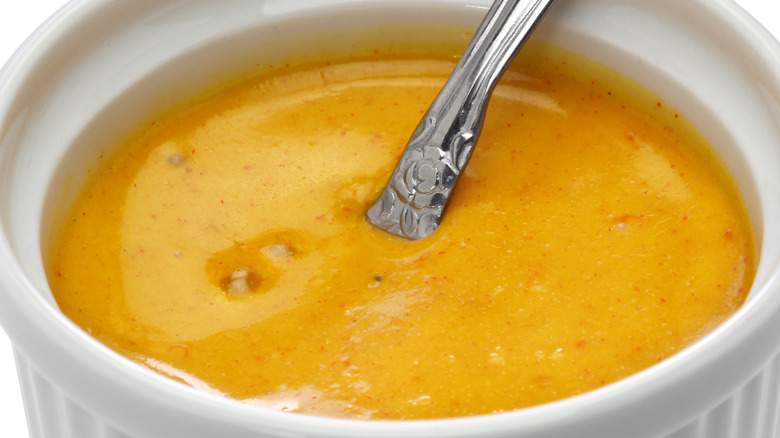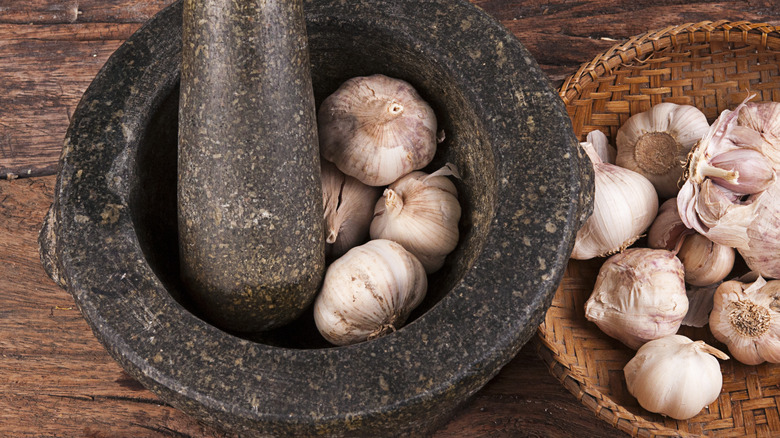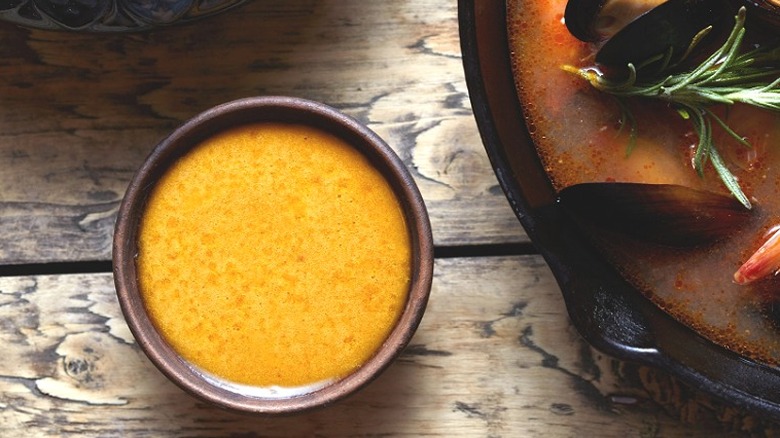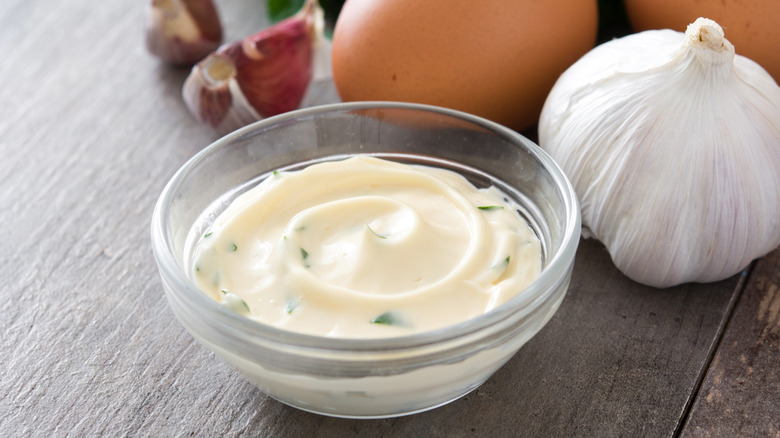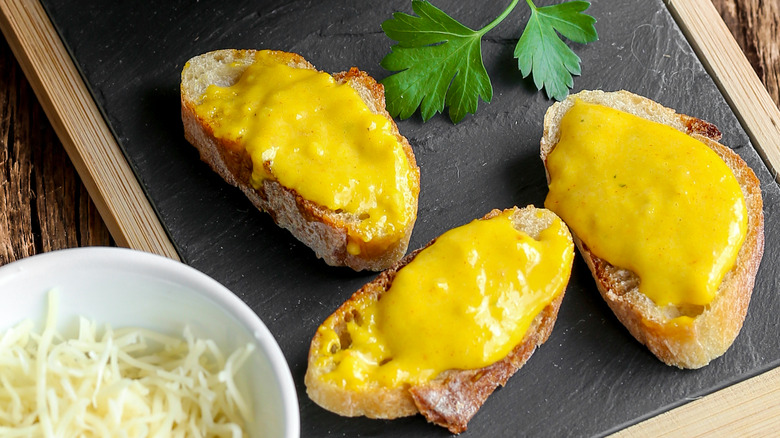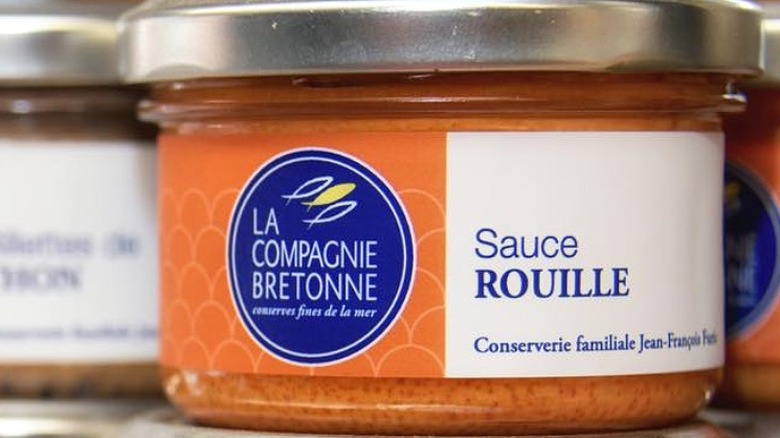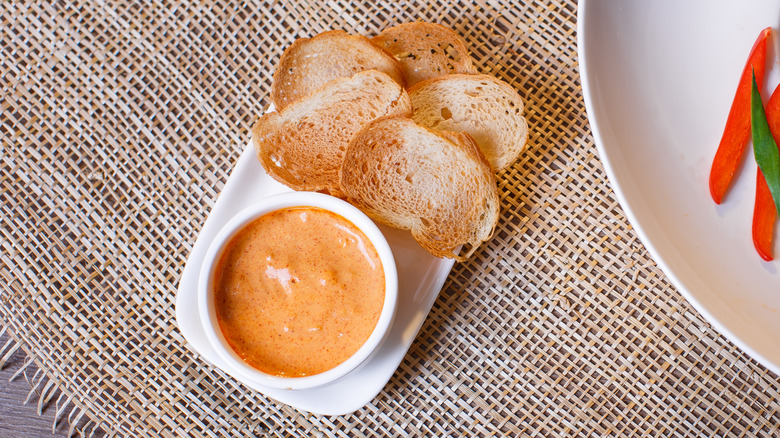What Is Rouille And How Is It Used?
We may receive a commission on purchases made from links.
Unless you're a fan of certain fish soups, you may have never heard of the sauce called rouille, but it's too delicious to make only for fish recipes. Taste Atlas shares that rouille hails from the Provence region of Southern France. It's most well-known as an integral component of the French seafood stew known as bouillabaisse, and it's also served with other fish dishes and soups. The name of the condiment translates to rust, so named because it can have a reddish-brown color. In addition to a striking color, the sauce has a thick, smooth texture, similar to that of aioli, a garlicky mayonnaise that is also used extensively in the Provence region, per What's Cooking America.
Rouille came to prominence as a key ingredient in bouillabaisse, a stew for poor fishermen that is now the signature dish of the city of Marseilles, according to Marvellous Provence. The sauce goes hand-in-hand with the stew and has helped to define the region.
How is rouille made?
According to Taste Atlas, the principal ingredients of rouille are garlic, saffron, egg yolks, hot peppers, bread, and olive oil. The traditional way to make the sauce is to grind ingredients together using a mortar and pestle. Martha Stewart makes her version of the condiment by combining saffron threads with boiling water to soften them and bring out their flavor. Bread is then placed in the saffron water to soak up the liquid, while garlic cloves and chili peppers get mashed with salt into a paste with a mortar. Egg yolk and oil are mixed in with the soaked bread and garlic, along with crushed cayenne chili peppers, and gently combined to bring the rouille sauce together. Stewart also adds paprika to her recipe, which enhances the color.
There are variations between different recipes. The New York Times recommends using a food processor to bring the ingredients together, and they advise thinning the sauce with a bit of fish broth. On the other hand, Emeril Lagasse's official version calls for roasted bell peppers for a different set of flavors.
What does rouille taste like?
According to Epicurious, some say, "bouillabaisse without rouille is like Marseille without sunshine." They note that the sauce brings a richness to the stew, with a strong garlicky flavor. PBS describes the flavor of the condiment as creamy and slightly spicy. The heat level of the sauce will depend on the peppers used in the blend, if they're fresh or dried, and how many peppers get used.
Garlic and chiles are not the only flavors found in rouille — there's also the saffron. The Kitchn says that describing saffron's taste can be tricky. Some people compare it to flowers, while others liken it to honey. Rouille also has a creamy mouthfeel thanks to the bread that's blended into the sauce to thicken it, as well as the emulsified olive oil. With a decadent sauce like this, you can't go wrong introducing a bit of this condiment into your meal plan.
Aioli versus rouille
Aioli is a thick garlic sauce that in its most original form is made with only garlic and olive oil, worked together vigorously to create a mayonnaise-like emulsion. Eventually, aioli evolved to include other ingredients like egg yolks to create a more stable and easier to achieve emulsion. This sauce is distinguished from mayonnaises and other condiments by the strong flavor it has from garlic and pure olive oil. The color of aioli can range from white to pale yellow.
Rouille bears many similarities to aioli. According to Taste Atlas, it's a traditional sauce of the same Provence region of France, and the rust-colored sauce is also made with lots of garlic and with olive oil. There are important differences between the two. For one, the bread or breadcrumbs that are only sometimes used to thicken aioli are always used when making rouille. Bold color also sets the condiments apart — with chiles and saffron in the blend, rouille should be a shade of reddish-brown. Rouille additionally has a more complex and heated flavor from the combination of garlic, saffron, and spicy peppers.
How rouille is used
The most well-known use for rouille is as an accompaniment to the French stew bouillabaisse. NPR shares that bouillabaisse is traditionally served in two courses and accompanied by croutons or small slices of bread topped with the condiment. These pieces of bread topped with rouille are dipped into the soup before eating, making for a unique flavor experience. Since rouille so perfectly compliments the fish in bouillabaisse it's a natural pairing for other seafood soups and dishes too, or as a condiment for fried foods, per PBS.
Food & Wine shares that Anthony Bourdain included the sauce in another traditional fish stew, Soupe de Poisson, where croutons spread with the sauce are placed right into the broth. Martha Stewart says that the spicy, garlicky condiment is delicious with pork dishes, too. She also uses the item to create a simple appetizer, Rouille On Croutons, by spreading it on toasted slices of baguette, according to marthastewart.com.
Where to find rouille
The best way to experience rouille is to make a fresh batch of your own. The ingredients are easy to find, and making your own allows you to control how spicy the final sauce will be. Saffron may prove to be the most expensive and hardest ingredient to come by, but you can look at it as an investment – The Kitchn notes that recipes typically only need a few threads at a time.
If you don't feel like whipping up a batch of your own rouille, a few outlets carry this unique condiment. There are some jarred forms of the condiment available to purchase online. Amazon sells Bénédicta brand sauce. Walmart additionally carries a version made by Delices du Luberon. If you get lucky, you might stumble upon the product in your area, but when in doubt, opt to buy this product online.
Rouille's nutritonal informaton
According to Nutritionix, one serving of rouille has roughly 76 calories and 262 milligrams of sodium. There are 8 total grams of fat with 1.2 grams of saturated fats. The sauce also has trace amounts of iron, vitamin C, and A.
Homemade rouille also contains raw egg yolk, per Food and Wine. This is typical of certain foods like homemade mayonnaise, Hollandaise sauce, and soufflés (via What's Cooking America). The raw egg yolk in the sauce can pose a risk of foodborne illness, especially for vulnerable individuals such as elderly adults, young children, and people with compromised immune systems, according to the Centers for Disease Control. To reduce this risk when making rouille, use pasteurized egg yolks, as PBS recommends in their recipe. To find some, The Pioneer Woman says to check your grocery store for cartons of eggs specifically labeled as pasteurized, which means they've been heated just enough to kill salmonella bacteria.
